中国先秦发明列表
先秦[编辑]
在新石器时代之后考古挖掘首先出现在中国的发明,特指是在商朝(前1600年-前1050年)期间或之后者,列于下方。
- 针灸:针灸,是将针头插入穴位以达成治疗与减轻疼痛的传统中医学疗法。它在前3世纪到2世纪(战国时代至汉朝)完成的著作《黄帝内经》中首次提到。[1]已知最古老针灸用针是金子做的,是在西汉(公元前202-后9年)中山靖王刘胜(殁于前113年)墓中发现;目前所知最古老、描述针灸的石雕是在东汉(25年-220年);而已知最古老的针灸铜人是在宋朝(960年-1279年)王惟一于1027年完成的「天圣铜人」。[2] 针灸目前仍用于治疗小儿夜尿症,即所谓尿床症状。[3]

- 生肖:在过去提到12生肖的文献中最早最完整的版本与现今版本略有不同(例如,龙不存在,其位置由虫代替)。[4]每种动物与一相地支相匹配,并记录在竹简上。这种竹简即是睡虎地秦简之一,可追溯到前4世纪晚期;[5]在天水放马滩亦有此发现,可追溯到前3世纪后期。[5]在这些考古发现之前,东汉王充(27年-97年)在1世纪期间所著《论衡》提供了最早并广为流传的完整12生肖循环。[6][7]对后世的突厥、蒙古、哈萨克族历法皆有影响。[8][9][10]
- 醴酒:从巴比伦尼亚到古埃及的古代世界中普通啤酒酒精含量仅有的4%到5%,而在西方世界一直要到12世纪蒸馏酒在意大利制造出来,酒精含量才达到11%以上。[11]中国古人自商朝(约前1600年-前1050年)即开始消耗普通啤酒,甚至在殷商骨卜铭文中提到它是一种献祭给神明的贡品。[12]学者罗伯特·坦普尔(Robert Temple)写道:「普通啤酒的主要问题是米粒内含的淀粉不能发酵。几千年前,人们发现发芽中的稻作里含有一种物质(现在知道这种酶叫做淀粉酶[13]),这种物质将谷物中的淀粉降解为糖,而糖可稍后再发酵。这是世界各地酿造古啤酒的基础。」[12]然而,于前1000年左右,中国老祖先们酿制出一种酒精饮料,其酒精含量高于11%。这种新酒精饮料在整个周朝(约前1050-前256年)诗歌里皆被提及。[14][12]这种新制程酿制出小米酒,而坦普尔介绍说:「这包括磨碎的半熟米(或偶尔使用小米)谷物,已让其发霉。这些霉所制造的淀粉消化酶比起发芽中谷物里的淀粉酶更有效率。[这种饮料]因此是一种霉加酵母的混合物。中国先民们将之与熟米在水中混合,这结果酿出了啤酒。淀粉酶将淀粉降解成糖而酵母将之发酵成酒。」[12]古人发现,若在发酵过程中加入更多熟米则酒精含量增加。[15] 这种制程与日后日本人利用来酿造清酒(或称日本酒)制程一模一样。[16]
- 编钟:最早的一套完整编钟,共十六枚,出土于山西曲村晋侯墓地中的8号晋侯稣墓。[17]这套十六枚钟上共刻有355字的长篇铭文,描述了晋侯稣在一次周厉王领导下征战参与。[18][19]晋侯稣墓为加速器质谱(AMS)14测年技术限制在前815–前786年。[20]早在周代(约前1050—前771年),就出现了能发出两个不同音高的编钟。[21]于前433年下葬的曾侯乙六十四枚编钟,四十七件能敲出小三度音程的两个音级,其余十六件能敲出大三度音程的两个音级。钟的前身为金属量谷器;前6世纪后,编钟还曾作为度量衡的基准,中国的度、衡、量、容积之单位皆以钟的音声乐调确立标准,如《国语》所言。[22]钧,2.1米长的调音器为钟长度的标准单位。钟本质上为古代十二律中的音叉,后为十二个定音管所取代。[21] 在制作金属编钟的过程,必须具备一定条件:不同金属合金的合理比例、物质的弹性与厚度、密度、直径、曲线、铸造温度及冷却速率等。[23]

- 铸铁:由熔融生铁所制造出的铸铁,目前所确认的考古证据,是在周朝(前1122年-前256年)前5世纪早期,最古老的样本是在江苏省六合县中一处陵墓所发现;尽管如此,考古学家所发现最早的高炉和熔铁炉,是在汉朝(前202年-220年)汉武帝(约前141年-前87年)于前117年颁行国家垄断铁的生产之后;学者唐纳德·瓦格纳(Donald Wagner)指出,迄今无任何古老的锻铁制程出土的一种可能原因是因为政府垄断铁的生产制造,而这种情况一直持续到公元1世纪为私人商贾及地方行政的权益方才废止,此举消灭了对过去在世界其他地区仍旧使用之持续、低效锻铁过程的任何需要。[24][25][26][27][28]瓦格纳指出,大部分早期中国的铁工具由于考虑到生产铸铁的经济负担较轻,故以铸铁制造,而相较之下大部分铁制武器皆以更昂贵的熟铁与钢制造,这意味著「武器的高性能至关重要」,并倾向使用后者打造。[29]
- 高炉:尽管在中国所发现的铸铁制工具和武器可追溯到前5世纪,不过所发现最古老生产生铁的中国高炉是建于前3到2世纪,其生产出来的生铁可在熔铁炉中重熔和精炼成铸铁,而早期发现绝大多数的高炉遗址是在汉朝(前202年-220年)汉武帝时期(公元前141-前87年)随著前117年国家垄断盐铁业的确立而建造;大部分建于前117年前铁工遗址仅作铸造厂之用,而这些铸造厂将四散于远离人口中心许多偏远地区里高炉冶鍊出的产品铸造成铁。[24][30]

- 熔铁炉:学者文森特·C·毕翰道(Vincent C. Pigott)指出,熔铁炉在中国至少在战国时期(前403年-前221年)就已存在,[31]而学者唐纳德·C·瓦格纳(Donald C. Wagner)写道,某些铁矿石在高炉中熔化可能已被直接铸入模具,不过在汉朝(公元前202-后220年)大部分铁,即使不是全部,在高炉熔鍊者皆在熔铁炉再熔过;其目的是使冷风于底部注入风口管,经过酬载(即木炭、废铁、或生铁)倒下处顶部送出,空气在到达炉底前就被预热成了热风,铁在炉底融化并稍后被注入适当的模具以铸造。[32]毕翰道指出,即使在现代的熔铁炉,有时注氧过多足以导致脱碳,这将导致低碳铁的疙瘩在炉内出现,类似于锻铁炉里的熟铁;虽然古人约在铸铁出现(春秋时期,前722年-前481年)的同时(约前500年)鍊出了熟铁(毕翰道表示,这毫无疑问的是从熔铁炉产生),然而并没有直接的证据表明,锻铁炉在中国曾经存在过。[33]
- 经济地图:在天水秦国墓中出土的放马滩七幅战国地图,年代可追溯到前4世纪的战国晚期(前403–前221年),徐美苓(Mei-ling Hsu)指出其中两幅以嘉陵江流域为中心的地图描绘出数个木料聚集处与采集地点的测量距离,能视为古经济地图。这两幅出土地图早于后来罗马地理学家斯特拉波(约前64–约24年)所绘制的经济地图。[34]

- 使用风箱、芥末烟雾、和石灰进行化学战:如在前4世纪墨家信徒的书面描述,先民们于战国时期(前403年-前221年)即将芥末植物(不要与现代芥子气混淆)烧结成球应用于战争中作为一种毁灭性战剂。[35]在攻城战时,攻城的一方往往会在城墙下挖坑道以破坏防守方的防御工事。[35]如墨家的书面描述,防守方亦可选择开凿竖井以与敌方的地下隧道交会,并在此连在火炉的风箱可用来将燃烧中的芥末和其它植物产生的毒气打进竖井。[36][35]汉(前202年-220年)末178年为对抗农民起义,汉朝战车驭者利用便携式风箱将石灰烟打向敌方,最终将之击败。[37]粉状石灰也用在抛射催泪瓦斯炸弹上,如宋朝(960-1279年)岳飞(1103年-1142年)在1135年利用它非常成功地讨灭杨么;根据其战役记述,当时石灰在空气中形成大雾,杨部「贼兵不能开目」。[38][37]
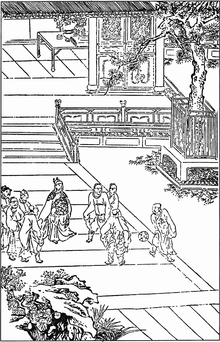
- 蹴鞠:身为现代足球的前身,蹴鞠由两种历史文献:《战国策》(于前3世纪至前1世纪编纂)[39]与司马迁(前145年-前86年)的《史记》(于前91年发表)[40]中首次提及。[41]这两种史书皆记载,在战国时期(前403年-前221年)齐国首都临淄的老老少少皆喜欢参与多人蹴鞠,以及其他如斗鸡等消遣活动,[39][40][41]玩蹴鞠除了身为平民的一种娱乐性体育竞技外,它也被视为是一种军事训练活动及一种让士兵保持身体健康的手段。[41]司马迁[42][43]与班固(32年-92年)在其《汉书》[44]中皆写道大将霍去病(前140年-前117年),在带领其部队攻击北方游牧民族匈奴后,让其士兵建造一座球场以便蹴鞠之用。[42][44][41]
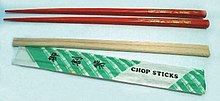
- 筷子:史家司马迁(前145年-前86年)于《史记》中所记商纣王是第一位自象牙制出筷子的人,时间于前11世纪;[45]考古所发现最古老的筷子出土于安阳侯家庄1005号商墓,铜制,约可追溯到前1200年。[46][47]到了前600年,筷子的使用已经传播到云南(大理大波那),[48][47]到了1世纪则传播到蒙古托夫省。[49]已知书面上最早提到筷子的使用是韩非于前3世纪所撰之《韩非子》。[50][51]

- 手持弩:在中国,青铜弩箭可追溯到前5世纪中期、位于湖北云台山的一处楚国墓葬遗址。[53]最早装有青铜板机的手持弩,可追溯到前6世纪、位于当时鲁国首都山东曲阜的第3号与第12号墓。[52][54]其它早期发现的弩是在湖南扫把塘第138号墓里发现,可追溯到前4世纪中期。[55][56]首先于《三国志》中提及的连弩,于1986年在湖北秦家嘴第47号墓里发现,可追溯到前4世纪左右。[57]最早于战斗中使用手持弩的文字证据,可追溯到前4世纪。[58][59]有著复杂青铜扳机机关的手持弩亦在秦始皇(约前221年-前210年)陵墓里兵马俑上发现,与后来汉朝(前202年-220年)出土样品类似,而在汉朝所描述弩手认识到队列操练,某些甚至武装到骑兵上,而汉朝学者将很多次汉匈战争胜利的原因归功于弩箭集射。[60][61]晁错(约前200年-前154年)于前169年写了一篇奏章上呈汉文帝,该奏章中涵盖了他认为汉弩优于匈奴弓的主张。[62][63]与其他设计出弩的同时期文明交叉比较,古希腊人有一种称之为“腹弩”(gastraphetes)的希腊弩(得名于射手得用其腹部顶住弩柄后端凹面处),这种弩在希罗的《武器制造法》(Belopoeica,写就于1世纪)一书中提及,[64]然而许多学者断言手持弩(一如在中国发明者)一直到10世纪才现身于欧洲。[65][66][67]不像中国发明的弩那样,希腊弩笨重体积巨大故它需要支架以让其保持固定,例如得将其架设在防御城墙上或者使用可移动的支架。[68]

- 胸式马带:古代世界从始至终,颈式马带被人们使用于驾驭拉车的马匹身上;然而这种马带大大限制马匹的能力,此乃因那种设计会不断地揪住马颈造成呼吸困难而使之无法挥洒自如。[69][70]一幅可追溯到西元前4世纪、来自楚国的漆奁上的图案,显示了已知最早将轭置放在横跨马胸部的使用范例。这种枷带有靷,连接到古战车车辕上。[71][72]横跨马胸、质地坚硬的轭逐步为靳所取代,而这是从汉朝(西元前202-后220年)以来墓葬浮雕和盖砖常常描绘的主题。[73]最后,马鞅终于在中国诞生,时间至少不晚于西元5世纪。[74][75]
- 牵引抛石机:最早的抛石机是人力牵引式抛石机,最先是在西元前5至4世纪的中国战国时代(前403—前221年)被发展;抛石机的操作是由人力拉动连在与木架上的旋转轴分开的一根长木杆绳索,使杆的另一端将石弹抛出;到了9世纪,一种人力配重式混合抛石机,采用人力和绕轴旋转重力,在中东、地中海与北欧被使用;到了12世纪,完善的配重式抛石机在阿尤布王朝的叙利亚与埃及出现(为Mardi bin Ali al-Tarsusi所描述),并在第三次十字军东征中使用;到了13世纪,配重式抛石机被蒙古可汗忽必烈(1260–1294年在位)引入中国,并在1267—1273年的襄樊之战中使用。[76][77][78]
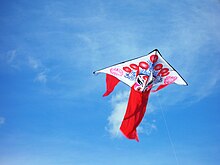
- 风筝:一如《墨子》所著,鲁国公输班(活跃西元前5世纪)用木头雕成鸟形在空中飞行3天,[79]其基本上就是个风筝;据记载,风筝在梁武帝(约西元502-549年)京城台城为侯景(死于西元552年)所围时曾被用作求救信号,[80],而与此类似以风筝用于军事信号的记述可见于唐朝(西元618-907年),[81]与金朝(西元1115-1234年);[82]风筝作为一种消遣,可追溯至北魏(西元386-534年)时期的敦煌壁画,而描写同样用途的文字叙述,可见于宋朝(960年-1279年)与明朝(1368年-1644年)的文献。[83][84][85][86]

- 通过适当食疗矫正营养缺乏病症:早在前4世纪的战国时期(前403年-前221年)前的记录显示,周朝宫廷聘用了食医。[88][87]首次以有规律的饮食来控制某些症状的明确描述可见于汉(前202年-220年)末张仲景(约150-约219年)所作《金匮要略》一书。[89][87]虽然张仲景不懂维生素的真正性质,他开立处方中的食品现今已为世人所知富含某些特定的维生素,而这些结果是在其大量试误后才发现对人有助益的。[87]唐代(618年-907年)诗人韩愈(768年-824年)观察到营养缺乏病症:脚气病(由于缺乏维生素B1产生)在江南远较江北更为普遍,[90]这考察结果在20世纪证实。[87]元朝(1271年-1368年)饮膳太医忽思慧(活跃于1314年-1330年)出版其著作《饮膳正要》,汇编了过往与此主题相关的大量书面材料。[87]在书中,忽思慧鉴识出两类型的脚气病(今日称为「湿性」与「乾性」脚气病)并开立富含维生素B1和以及他种维生素的食疗调补方。[87]后来,克里斯蒂安·艾克曼(1958年-1930年)在1929年获颁诺贝尔生理学或医学奖,表彰其发现脚气病是因为缺乏至关重要的维生素B1的不良饮食习惯所造成。
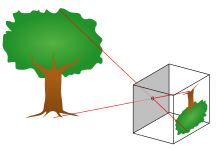
- 小孔成像:古希腊哲学家亚里士多德(西元前384-322年)观察到,介于树叶间的细缝可如小针孔般投射部分日蚀的影像到地面上。[91]他亦利用带小针孔的金属板来完成相同的实验。[91]恰好活在亚里士多德时代之前、诸子百家时代墨家的创始人墨子(西元前470-前391年),在其《墨经》(大概是其弟子所编)之中描述了个小孔成像。[92]《墨经》表示了「端」(针孔)是一处空洞「像在描绘皇旗上的太阳月亮般煦煦照射」,在此影像可在中心交叉点上下颠倒地投射,而该交叉点「影响影像大小」。[93][92]《墨经》所述似乎与伊壁鸠鲁学说中所述光线如何行进入眼符合(而不是如在毕达哥拉斯主义般反之亦然),[94]因为墨经指出,从「受光照射的人」反照出的光辉,通过针孔后变得颠倒,即「下者之人也高,高者之人也下」[92]阿拉伯学者海什木(西元965-1039年)在其《光学书》(撰于西元1021年)中写到有关他的暗箱实验;而该实验后来由沈括(西元1031-1095年)跟进。沈括是根据唐朝(西元618-907年)《酉阳杂俎》一书作者段成式(死于西元863年)所述塔倒影现象所做的辨正。[95][96]

- 斗栱:斗栱是一种中式建筑物特有的建筑托架。古人至少自西周(约前1050年-前771年)以来,就将它置于介于立柱顶与横梁间,用以支撑典型中国三层建筑的内凹式屋顶。[97]每个斗栱由木制、在每边承重木块(斗)支撑双弓形臂(拱)组成。[97]斗栱也被用于装饰和礼仪,而非皆具有支撑的实际用途,如建于1049年开宝寺琉璃塔的实心砖塔。由宋朝(960年-1279年)将作监少监李诫于1103年所刊行的《营造法式》插图介绍并描述了斗栱。[98]
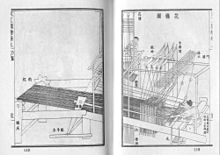
- 织布机:经考证最早织布机纺织品是来自楚国,可追溯日期约为前400年。[99]大多数学者将织布机归属于中国古代发明,尽管某些学者推测其为古叙利亚的发明,此乃因在杜拉欧罗普斯(Dura-Europos)城遗址所发现的织布机纤维被认为是256年之前之作。[99][100]学者迪特尔·库恩(Dieter Kuhn)指出,对来自汉朝(前202年-220年)文献与纺织品的一项分析证明,那时样式华丽的织物也是利用织布机缝制而成。[101]到了6世纪,可以肯定织布机已传入波斯。[99]学者埃里克·布劳迪(Eric Broudy)声称,在17世纪之前,几乎没有任何证据可证明织布机在欧洲使用,而小型织布机据说于15世纪由让·勒卡拉布里亚(Jean le Calabrais)所发明。[102]而学者玛丽·卡罗琳·鲍崔(Mary Carolyn Beaudry)则持不同观点,她指出织布机在中世纪被应用于意大利丝绸业。[101]
- 刀币、铲币:Robert S. Wicks指出贝壳曾在商代(约前1600—约前1050年)时期作为原始钱币。[103] 到了周朝(约前1050—前256年),不同形状的青铜钱币,如易于用绳子穿起来方孔或圆孔的环钱,[104] 与同时期的独特刀币、铲币成了通用的货币;据考古表明,它们主要用于春秋至战国时期(前771—前221年)的燕、齐、赵、韩、楚、梁、秦各国。[105]司马迁(前145—前86年)在他的《史记》写道龟壳、贝、刀与金曾在古代作为货币。[106]
- 以颜色对应方位:在中国古代建造祭坛时常将五色土施于五方。[107][108][109]最早的考古例子证据来自安徽双墩的春秋时期(前771—前481年)古墓。[110] “五色”一名在《尚书》与《左传》出现,而最早关于运用五色(即南红、中黄、东青、西白、北黑)的记载来自成书于战国时期(前403—前221年)的《考工记》,[111] 到了前2世纪中期因缺《冬官》,才把《考工记》编入《周礼》一书。[112][113][114]
- 兵家理论书:世界上最早的兵书为孙子(活跃于前6世纪)所撰的《孙子兵法》。[115] 最早有关孙子的文字记载是不晚于前122年所编的《淮南子》,[116] 司马迁在前109—前91年所撰的《史记》中为孙子立传。[117]现存最早的孙子兵法副本是1972年山东临淄汉墓中出土的银雀山汉简,墓主人约前140年—前118年下葬。银雀山汉简还包括了孙子后裔孙膑所撰的《孙膑兵法》。[118]

- 以天然气作为燃料:罗罗伯特·坦普尔(Robert Temple)声称,保守估计约在前4世纪的战国时期,中国人最早以天然气作为燃料和灯。[15]他指出,从上古到西元前1世纪(汉朝时期)为提取卤水所进行系统化钻探,结果在四川意外发现了许多的出产天然气的「火井」。[15]根据2世纪的记载,这导致古人系统化地寻找天然气。[15]卤水和天然气两者皆以竹管运送;自小型钻井流出的天然气可以直接输送到锅炉中作为燃料,在此处可用铸铁锅煮沸并蒸发卤水以提取盐,不过从深达2000英尺(610米)抽出的刺鼻天然气得需先与空气混合以免发生爆炸。[119]为了解决这个问题,古人把天然气先输送到一座置于低于地平面3米(10英尺)、木制大型锥状气室里,由另一个管道输送空气,从而把该气室转化成一种大型汽化机。[119]为避免瓦斯突然过剩造成火患,一个附加的「冲天笕」被当成排气系统使用。[120]
- 折叠伞:虽然阳伞在古巴比伦、希腊和罗马普遍存在,不过史上第一个有关于带机械滑杆并可折叠的伞的文字记载,可追溯到国祚不长的新朝(9-23年),当时王莽(约9-23年)在21年时要求匠人将之安装在仪式用四轮马车上。[121][122]汉朝(前202-220年)学者服虔于2世纪时注释道可折叠的伞备有可蜷曲的关节,供其延展或缩回。[123][124]实际上王莽时期(或稍晚时期)可折叠雨伞残骸已于考古挖掘汉代乐浪郡(位于今北朝鲜)王光墓时出土。[125]然而,有强烈的证据支持可折叠伞早在前6世纪周朝(前1122-256)时期就已出现,一如考古发掘出土,可追溯到那时的洛阳青铜制带沟槽、滑座、插销的复杂枢纽所建议。[125]到了魏朝(220-265年),常见伞面已由丝绸制变换到桑树皮厚油纸制,虽然当时仍能找到丝绸制伞。[126]
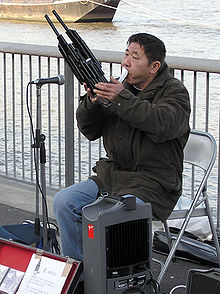
- 笙:使用金属活塞鼓风管风琴乐器在西方已有悠久的历史。[127]这是一项希腊亚历山大港居民的发明,并由古罗马工程师维特鲁威于西元前1世纪晚期详细描述,虽然目前大众提到它时更常联想到基督教礼拜仪式。[127]不过,西方管风琴没有利用上簧片,而中国古代口琴乐器则有。[127]中国古乐器:笙,传统上使用竹管制造,最早文献记载见于周朝(西元前1050-前256年)的《诗经》。[128][127]笙被认为是口琴、小风琴、六角手风琴、手风琴、和所有其他簧风琴乐器的鼻祖。[127]在西元13世纪时西域大食发明了簧管风琴,而德国辛里奇.塔克斯多夫(Heinrich Traxdorf,活跃于西元15世纪)在西元1460年左右于纽伦堡重造了一把。[129]学者认为,中国古笙在19世纪向西传播经过了俄罗斯,鉴于它当时在圣彼得堡的记述。[127]

- 古琴:以西方观点来说,古琴是来自中国、世界上最古老的齐特琴弦乐器,并至少自商朝(约西元前1600-前1050年)就已存在,鉴于出土的商朝卜骨上刻有琴字的甲骨文(为目前所知最古老的铭文)。[130]古琴最古老的样本是出土自曾侯乙(西元前433年)墓;学者博·拉文格林(Bo Lawergren)认为,它可能从像箜篌这种中东竖琴发展而来,而箜篌最早出土样本是在新疆省且末县,可追溯到西元前400-前200年。[131]许多学者表示它在周朝(西元前1050-前256年)时期流行,而已知最古老的成文古琴指法乐谱可追溯到汉朝(西元前202-后220年)。[130]当自唐朝以来文人雅士将古琴尊为四艺之一,以及沈括将其描述为「九客」之一时,[132]它后来演变成与古仕绅阶层高度相关的一种乐器;[133]它甚至成为某些绘画艺术品中的特色,如在西元12世纪由宋徽宗本人所作《听琴图》。

- 围棋:虽然古代传说(可能汉朝后人所托伪作)记载神话时代的尧造了围棋,[134]不过现有文献中得知围棋自至少西元前10世纪的周朝就已经存在(西元前1050-前256年),并且甚至以书面形式为孔子(西元前551-前479年)、[135]孟子(西元前371-前289年)[136]所提到,虽然孔孟两者皆对围棋稍稍抱持著负面看法。[135][136][137][138]

- 六博:现已佚失的棋盘游戏六博,其游戏的大部分对现今千方百计去解密该游戏怎样玩的学者仍是个谜;它与赌博及占卜两者的关连性使其成为一种独特的游戏。[139][140]最早的两个六博棋盘是在河北省石家庄市中山3号墓中发现。[141][142]与之类似可追溯西元前4世纪中叶的发现,亦在湖北江陵楚197号与314号墓中发现。[141][143]许多西汉(西元前202-后9年)时期墓葬的六博棋盘已为考古学者所发现;,1块木制棋盘在江苏省江都市出土;1块木制棋盘在湖北凤凰山8号墓发掘;一整套漆器六博在湖南马王堆3号墓出土;一漆器棋盘于云南大坟头1号墓;一铜制棋盘于广西西林。[144]在汉朝时期,对一局六博终局占卜徵兆的争论导致当时仍是太子的汉景帝刘启与吴国太子刘贤之间的斗殴。刘贤后来丧生,这挑起了其父吴王刘濞掀起七国之乱(西元前154年)造反。[145][139]历史学家迈克尔·洛伊由此断言,一套六博棋子布局象徵著中国古代的物质观:五行。[140]
- 重型带犁板铁犁:虽然在中国,古人何时使用简易木制犁的确切时代一定较后面日期更早,不过目前所发现最早的铁犁可追溯大约至西元前500年周朝(西元前1122-前256年)时期。当时的原始铁犁底部是平坦、V型、且装有木杆与手把。[146][147]到了西元前3世纪,铸铁铸造技术的改善导致重型带犁板铁犁的发展,一如汉朝(西元前202-后220年)时期墓刻砖等等艺术作品所示。[146]犁板让古人在翻土同时利用手推车两侧的犁板将泥推到两边,使得犁头不为土壤所阻塞。[148]虽然现今出土的战国时期(西元前403-前221年)犁头与犁架除铁铲大部分以木制,易于腐朽,不过到了汉朝时期的犁头与犁架整件已完完实实都是铁制,且其上装有犁板可将土翻起。[149]
参考文献[编辑]
引用[编辑]
- ^ Omura (2003), 15.
- ^ Omura (2003), 19 & 22.
- ^ Helmer (2006), 51, 107, & 120.
- ^ Zhao (2000), 6–9.
- ^ 5.0 5.1 Loewe (1999), 847.
- ^ Sterckx (2002), 66–67.
- ^ 见《论衡》物势篇第十四与言毒篇第六十六
- ^ Lewis (1994), 10.
- ^ Gleadow (2001), 89.
- ^ Svanberg (1989), 211.
- ^ Temple (1986), 77 & 103.
- ^ 12.0 12.1 12.2 12.3 Temple (1986), 77.
- ^ 淀粉酶,古称「曲蘖」
- ^ 例如《楚辞》招魂篇,原文:「……挫糟冻饮,酎清凉些。……」又见《尚书》说命下,原文:「……若作酒醴,尔惟麴糵……」
- ^ 15.0 15.1 15.2 15.3 Temple (1986), 78.
- ^ Temple (1986), 77–78.
- ^ Wang (2007), 8 & 26.
- ^ Xu (1996), 197 fn. 20, 204.
- ^ Li (2006), 86.
- ^ Guo et al. (1996), 1112–1114.
- ^ 21.0 21.1 Temple (1986), 199–200.
- ^ Temple (1986), 199.
- ^ Temple (1986), 200–201.
- ^ 24.0 24.1 Wagner (2001), 7, 36–37, 64–68.
- ^ Ebrey, Walthall, and Palais (2006), 30.
- ^ Gernet (1996), 69.
- ^ Wagner (1993), 335.
- ^ Pigott (1999), 177.
- ^ Wagner (1993), 336.
- ^ Pigott (1999), 183–184.
- ^ Pigott (1999), 191.
- ^ Wagner (2001), 75–76.
- ^ Pigott (1999), 177 & 191.
- ^ Hsu (1993), 92-93.
- ^ 35.0 35.1 35.2 Temple (1986), 215.
- ^ 见《墨子》卷十四备穴
- ^ 37.0 37.1 Temple (1986), 217.
- ^ 见《老学庵笔记》卷一,原文:「鼎澧群盗如钟相、杨么(乡语谓幼为么)……官军乃更作灰炮,用极脆薄瓦罐,置毒药、石灰、铁蒺藜于其中,临阵以击贼船,灰飞如烟雾,贼兵不能开目。欲效官军为之,则贼地无窑户,不能造也,遂大败。……」
- ^ 39.0 39.1 见《战国策》卷八,原文:「……临淄甚富而实,其民无不吹竽、鼓瑟、击筑、弹琴、斗鸡、走犬、六博、蹴踘者……」
- ^ 40.0 40.1 见《史记》卷六十九 苏秦列传 第九,原文:「……临灾甚富而实,其民无不吹竽鼓瑟,弹琴击筑,斗鸡走狗,六博蹋鞠者。……」
- ^ 41.0 41.1 41.2 41.3 Speak (1999), 32.
- ^ 42.0 42.1 见《史记》卫将军骠骑列传,原文:「天子为治第,令骠骑视之,对曰:『匈奴未灭,无以家为也。』……而骠骑尚穿域蹋鞠。……」
- ^ Watson (1961 II), 178.
- ^ 44.0 44.1 见《汉书》卷五十五 卫青霍去病传第二十五,原文:「去病为人少言不泄,有气敢往……而去病尚穿域蹴鞠也。……」
- ^ 见《史记》宋微子世家,原文:「……箕子者,纣亲戚也。纣始为象箸,……」
- ^ Lu, Maocun. An Introduction to Chopsticks. Agricultural Archaeology. 2004, No. 1: 209–216. ISSN 1006-2335.
- ^ 47.0 47.1 Le due leggende sulle bacchette cinesi. Italian.cri.cn. 2008-06-19 [2009-07-14]. (原始内容存档于2016-04-12).
- ^ Lu (2004), 209–216.
- ^ The National Museum of Mongolian History. 华盛顿大学. [2008-07-20]. (原始内容存档于2020-05-03).
- ^ 见《韩非子》喻老篇,原文:「……昔者纣为象箸而箕子怖,以为象箸必不加于土铏,必将犀玉之杯;象箸玉杯必不羹菽藿,……」
- ^ Needham (1986), Volume 6, Part 5, 104, footnote 161.
- ^ 52.0 52.1 You (1994), 80.
- ^ Wagner (1993), 153, 157–158.
- ^ Stephen Selby. A Crossbow Mechanism with Some Unique Features from Shandong, China. Asian Traditional Archery Research Network. 2001 [2008-08-20]. (原始内容存档于2008-05-18).
- ^ Mao (1998), 109–110.
- ^ Wright (2001), 159.
- ^ Lin (1993), 36.
- ^ 见《百战奇略》卷三
- ^ Wright (2001), 42.
- ^ Needham (1986), Volume 5, Part 6, 124–128.
- ^ Lewis (2000a), 45.
- ^ 见《汉书》卷四十九 爰盎晁错传第十九
- ^ Di Cosmo (2002), 203.
- ^ Campbell (2003), 3–6
- ^ Needham (1986)Volume 5, Part 6, 170–172
- ^ Brodie & Brodie (1973), 20 & 35.
- ^ DeVries (2003), 127–128.
- ^ Campbell (2003), 4.
- ^ Needham (1986), Volume 4, Part 2, 305.
- ^ Temple (1986), 20.
- ^ Needham (1986), Volume 4, Part 2, 310.
- ^ Temple (1986), 21.
- ^ Needham (1986), Volume 4, Part 2, 308–312.
- ^ 引证错误:没有为名为
needham volume 4 part 2 319 323的参考文献提供内容 - ^ Needham (1986), Volume 4, Part 2, 22–23.
- ^ Chevedden (1998), 179–222.
- ^ Turnbull (2001), 9, 45–46.
- ^ Chevedden (1999), 36.
- ^ 见《墨子》鲁问篇,原文:「……公输子削竹木以为鹊,成而飞之,三日不下……」
- ^ 见《独异志》卷中,原文:「梁武帝大清三年,侯景反,围台城,远近不通。简文与太子大器为计,缚鸢飞空,告急于外。……」
- ^ 见《新唐书》列传第135藩镇魏博
- ^ 见《金史》卷一百一十三 列传第五十一,原文:「……城上悬红纸灯爲应,约灯起渡壕,又爲围者所觉。又放纸鸢,置文书其上,至北营则断之,以诱被俘者。识者谓前日纸灯、今日纸鸢,宰相以此退敌难矣。……」
- ^ 宋代表性著作见宋徽宗《宣和风筝谱》
- ^ 例如明徐渭《风筝诗》:「柳条搓线絮搓棉,搓够千寻放纸鸢。消得春风多少力,带将儿辈上青天。我亦曾经放纸嬉,今来不道老如斯。那能更驻游春马,闲看儿童断线时。」
- ^ Day & McNeil (1996), 295.
- ^ Needham (1986), 577–578.
- ^ 87.0 87.1 87.2 87.3 87.4 87.5 87.6 Temple (1986), 131.
- ^ 见《周礼》天官冢宰,原文:「……食医:掌和王之六食、六饮、六膳、百羞、百酱、八珍之齐。凡食齐视春时,羹齐视夏时,酱齐视秋时,饮齐视冬时。凡和,春多酸,夏多苦,秋多辛,冬多咸,调以滑甘。凡会膳食之宜,牛宜稌,羊宜黍,豕宜稷,犬宜粱,雁宜麦,鱼宜菰。凡君子之食,恒放焉。……」
- ^ 见《金匮要略》
- ^ 见《祭十二郎文》,原文:「……汝去年书云:『比得软脚病,往往而剧。』吾曰:『是疾也,江南之人,常常有之,未始以为忧也。』……」
- ^ 91.0 91.1 Clee (2005), 6.
- ^ 92.0 92.1 92.2 Needham (1986), Volume 4, Part 1, 82.
- ^ 见《墨子》经说下,原文:「...景光之人煦若射,下者之人也高,高者之人也下。足敝下光,故成景于上;首敝上光,故成景于下。在远近有端与于光,故景库内也。...」与经下,原文:「...景倒,在午有端与景长,说在端。...」
- ^ Needham (1986), Volume 4, Part 1, 85.
- ^ 见《酉阳杂俎》卷四 物革,原文:「咨议朱景玄见鲍容说,陈司徒在扬州,时东市塔影忽倒。老人言,海影翻则如此。」以及《梦溪笔谈》卷三辨证一,原文:「...《酉阳杂俎》谓『海翻则塔影倒』,此妄说也。影入窗隙则倒,乃其常理。」
- ^ Needham (1986), Volume 4, Part 1, 97–98.
- ^ 97.0 97.1 Fletcher (1996), 693.
- ^ Needham (1986), Volume 4, Part 3, 100.
- ^ 99.0 99.1 99.2 Broudy (1979), 124.
- ^ Forbes (1987), 218 & 220.
- ^ 101.0 101.1 Beaudry (2006), 146.
- ^ Broudy (1979), 130–133.
- ^ Wicks (1992), 28.
- ^ Hartill (2005), 80–83.
- ^ Hartill (2005), 4–76.
- ^ Hartill (2005), 4.
- ^ Isabel (1995), 370.
- ^ Li (2002), 54. (For photo of Altar of Land and Grain five different soil colors).
- ^ Twitchett (1998), 874.
- ^ Tomb.1 of Shuangdun burial from Spring and Autumn Period (页面存档备份,存于互联网档案馆) (Chinese). Xinhua. Retrieved on 2008-7-25
- ^ Shao (2002), 52.
- ^ Ko (2007), 265.
- ^ Lewis (2006), 177.
- ^ Loewe (1999), 457.
- ^ Giles (2007), VII–VIII.
- ^ Giles (2007), XIV.
- ^ Giles (2007), XI–XII.
- ^ Tan (2002), 18.
- ^ 119.0 119.1 引证错误:没有为名为
temple 1986 78 79的参考文献提供内容 - ^ Temple (1986), 79.
- ^ 见《汉书》卷九十九下 王莽传第六十九下,原文:「或言黄帝时建华盖以登仙,莽乃造华盖九重,高八丈一尺,金瑵羽葆,载以秘机四轮车,驾六马,力士三百人黄衣帻,车上人击鼓,挽者皆呼「登仙」。莽出,令在前。成官窃言:『此似软车,非仙物也。』」
- ^ Needham (1986), Volume 4, Part 2, 70.
- ^ 《汉书》服虔注:「盖髙八丈,其杠皆有屈膝,可上下屈伸也」
- ^ Needham (1986), Volume 4, Part 2, 70–71.
- ^ 125.0 125.1 Needham (1986), Volume 4, Part 2, 71.
- ^ Temple (1986), 96.
- ^ 127.0 127.1 127.2 127.3 127.4 127.5 Needham (1986), Volume 4, Part 1, 211.
- ^ 见《诗经》小雅‧甫田之什‧宾之初筵,原文:「……龠舞笙鼓,乐既和奏,烝衎烈祖,以洽百礼。……」;小雅‧鹿鸣之什‧鹿鸣,原文:「……呦呦鹿鸣,食野之苹。我有嘉宾,鼓瑟吹笙。吹笙鼓簧,承筐是将。人之好我,示我周行。……」;小雅‧谷风之什‧鼓锺,原文:「……鼓锺钦钦,鼓瑟鼓琴。笙磬同音。以雅以南,以龠不僭。……」
- ^ Needham (1986), Volume 4, Part 1, 211–212.
- ^ 130.0 130.1 San Diego Chinese Historical Museum. (2001年5月 - 8月). Gu Qin: Traditional Chinese Zithers. Sdchm.org. [2008-08-03]. (原始内容存档于2005-08-07).
- ^ Origins of the Qin. silkqin.com. [2008-08-22]. (原始内容存档于2020-11-01).
- ^ 见《梦溪笔谈》章节不详,原文:「……游于泉,舫于渊,俯仰于茂木美荫之间,与之酬酢于心月之所寓者:琴、棋、禅、墨、丹、茶、吟、谈、酒,谓之九客。……」
- ^ Lian (2001), 20.
- ^ 见《世本》清张澍稡集补注本·作篇,原文:「……尧造围棋,丹朱善之。……」
- ^ 135.0 135.1 例如,见《论语》阳货篇,原文:「子曰:『饱食终日,无所用心,难矣哉!不有博弈者乎?为之,犹贤乎已!』」
- ^ 136.0 136.1 见《孟子》离娄下,原文:「……博弈、好饮酒,不顾父母之养,二不孝也;……」
- ^ Lasker (1960), xiii.
- ^ Shotwell, Yang, and Chatterjee (2003), 133.
- ^ 139.0 139.1 Loewe (1986), 141.
- ^ 140.0 140.1 Loewe (1968), 144–145.
- ^ 141.0 141.1 Li (2004), 8–9 & 13.
- ^ Handler (2001), 181.
- ^ Loewe (1999), 839.
- ^ Li (2005), 66–68.
- ^ 见《史记》卷106 吴王濞列传 第46,原文:「……孝文时,吴太子入见,得侍皇太子饮博。吴太子师傅皆楚人,轻悍,又素骄,博,争道,不恭,皇太子引博局提吴太子,杀之。于是遣其丧归葬。……」
- ^ 146.0 146.1 Greenberger (2006), 11.
- ^ Bray (1978), 9 & 19–21.
- ^ Greenberger (2006), 11–12.
- ^ Wang (1982), 53–54.
书目[编辑]
- Aczel, Amir D (2002). The Riddle of the Compass: The Invention that Changed the World. 聖地牙哥:Harcourt. ISBN 0156007533.
- Addington, Larry H. (1990). The Patterns of War Through the Eighteenth Century. 印第安那大學出版社。ISBN 0253205514.
- Adshead, Samuel Adrian Miles. (2000). China in World History: Third Edition. 倫敦:麥美倫出版社股份有限公司。紐約:聖馬丁出版社。ISBN 0312225652.
- Adshead, S.A.M. (2004). T'ang China: The Rise of the East in World History. 紐約:Palgrave Macmillan. ISBN 1403934568 (hardback).
- Allan, Sarah (1991). The Shape of the Turtle: Myth, Art and Cosmos in Early China. 紐約:紐約州立大學出版社。ISBN 0791404595.
- (简体中文)An, Lihua(安立华),《The Origin of Golden Crow Bearing Sun Image on Han Dynasty's Painting》(汉画像“金乌负日”图象探源),《东南文化》,(1992年),第Z1期,66–72,ISSN 1001-179X。
- Angier, Natalie (2007). The Canon: A Whirligig Tour of the Beautiful Basics of Science. 波士頓:霍顿·米夫林。ISBN 0618242953.
- Arndt, Jörg, and Christoph Haenel. (2001). Pi Unleashed. Translated by Catriona and David Lischka. 柏林:Springer. ISBN 3540665722.
- Asiapac Editorial. (2004). Origins of Chinese Science and Technology. Translated by Yang Liping and Y.N. Han. 新加坡:Asiapac Books Pte. Ltd. ISBN 9812293760.
- Balchin, Jon. (2003). Science: 100 Scientists Who Changed the World. 紐約:Enchanted Lion Books. ISBN 1592700179.
- Beaudry, Mary Carolyn. (2006). Findings: The Material Culture of Needlework and Sewing. 纽黑文:耶魯大學出版社。ISBN 0300110936.
- Bellwood, Peter (2004). First Farmers: The Origins of Agricultural Societies. Malden, MA: Blackwell Pub. ISBN 0631205667.
- Bellwood, Peter. (2006). "Asian Farming Diasporas? Agriculture, Languages, and Genes in China and Southeast Asia," in Archaeology of Asia, 96–118, edited by Miriam T. Stark. Malden: Blackwell Publishing Ltd. ISBN 1405102128.
- Benn, Charles. (2002). China's Golden Age: Everyday Life in the Tang Dynasty. 牛津大學出版社。ISBN 0-19-517665-0.
- Berggren, Lennart, Jonathan M. Borwein, and Peter B. Borwein. (2004). Pi: A Source Book. 紐約:Springer. ISBN 0387205713.
- Bielenstein, Hans. (1980). The Bureaucracy of Han Times. 剑桥:剑桥大学出版社。ISBN 0521225108.
- Birrell, Anne (1993). Chinese Mythology: An Introduction. 巴爾地摩:約翰霍普金斯大學出版社。ISBN 0804723532.
- Block, Leo. (2003). To Harness the Wind: A Short History of the Development of Sails. 安那波利斯:美國海軍學院出版社。ISBN 1557502099.
- Bodde, Derk (1991). Chinese Thought, Society, and Science. 檀香山:夏威夷大學出版社。
- (英文)Bowman, John S. (2000年),《Columbia Chronologies of Asian History and Culture》(哥伦比亚大学亚洲历史文化年代史),纽约:哥伦比亚大学出版社。ISBN 0231110049。
- (英文)Bray, Francesca(白馥蘭),《Swords into Plowshares: A Study of Agricultural Technology and Society in Early China》in Technology and Culture, Vol. 19, No. 1 (Jan., 1978): 1–31.
- Brook, Timothy (2004). The Chinese State in Ming Society. 紐約:RoutledgeCurzon. ISBN 0415345065.
- Broudy, Eric. (1979). The Book of Looms: A History of Handlooms from Ancient Times to the Present. 漢諾瓦:新英格蘭大學出版社。ISBN 0874516498.
- Buisseret, David. (1998). Envisioning the City: Six Studies in Urban Cartography. 芝加哥:芝加哥大學出版社。ISBN 0226079937.
- Burnham, Barry C. “Roman Mining at Dolaucothi: The Implications of the 1991-3 Excavations near the Carreg Pumsaint”, in Britannia, 1997, Vol. 28:325–336.
- Campbell, Duncan (2003). Greek and Roman Artillery 399 BC-AD 363. 牛津:Osprey Publishing. ISBN 1841766348.
- Carlson, John B. "Lodestone Compass: Chinese or Olmec Primacy?" in Science, New Series, Vol. 189, No. 4205 (Sep. 5, 1975): 753–760.
- Ceccarelli, Marco (2004). International Symposium on History of Machines and Mechanisms. 波士頓:Kluwer Academic. ISBN 1402022034.
- Cepeda, Isabel Vilares (1995). Bibliografia da prosa medieval em lingua portuguesa: Subsidios. Lisboa: Ministério da Cultura. ISBN 9725652169.
- Chen, Cheng-Yih (1995). Early Chinese Work in Natural Science. 香港:香港大學出版社。ISBN 962209385X.
- Ch'en, Jerome. "Sung Bronzes--An Economic Analysis," in Bulletin of the School of Oriental and African Studies, Vol. 28, No. 3, (1965): 613–626.
- (简体中文)Chen, Xuexiang(陈雪香),《On the Buried Jade Unearthed in the Erlitou Site》(二里头遗址墓葬出土玉器探析),《中原文物》,(2003年),第3期,23–37,ISSN 1003-1731。
- (简体中文)Cheng, Shihua(程世华),《A shallow understanding of the diet of residents in Liangzhu》(良渚人饮食之蠡测),《農業考古》,(2005年),第1期,102–109,ISSN 1006-2335。
- Chevedden, Paul E. (1998). "The Hybrid Trebuchet: The Halfway Step to the Counterweight Trebuchet," in On the Social Origins of Medieval Institutions: Essays in Honor of Joseph F. O'Callaghan, 179–222, edited by Donald J. Kagay and Theresa M. Vann.萊頓:Koninklijke Brill. ISBN 9004110968.
- Chevedden, Paul E. (1999). "Fortifications and the Development of Defensive Planning in the Latin East," in The Circle of War in the Middle Ages: Essays on Medieval Military and Naval History, 33–44, edited by Donald J. Kagay and L.J. Andrew Villalon. Woodbridge: The Boydell Press. ISBN 0851156452.
- Christides, Vassilios. (1996). "New Light on the Transmission of Chinese Naval Technology to the Mediterranean World: The Single Rudder," in Intercultural Contacts in the Medieval Mediterranean, 64–70, edited by Benjamin Arbel. 倫敦:Frank Cass and Company Ltd. ISBN 0714647144.
- (英文)Chung, Chee Kit. (曾炽杰),《Longyamen is Singapore: The Final Proof?》(龙牙门就是新加坡:最后的证据?) 於《Admiral Zheng He & Southeast Asia》(鄭和與東南亞),(2005),新加坡:新加坡東南亞研究所。ISBN 9812303294.
- Clee, Paul. (2005). Before Hollywood: From Shadow Play to the Silver Screen. 紐約:Clarion Books, an imprint of Houghton Mifflin Company. ISBN 0618445331.
- Clunas, Craig. (2004). Superfluous Things: Material Culture and Social Status in Early Modern China. 檀香山:夏威夷大學出版社。ISBN 0824828208.
- Cotterell, Maurice. (2004). The Terracotta Warriors: The Secret Codes of the Emperor's Army. 羅徹斯特:Bear and Company. ISBN 159143033X.
- Cowley, Robert (1996). The Reader's Companion to Military History. 波士頓:霍顿·米夫林公司。
- Crespigny, Rafe de. (2007). A Biographical Dictionary of Later Han to the Three Kingdoms (23-220 AD). 萊頓:Koninklijke Brill. ISBN 9004156054.
- Croft, S.L. (1997). "The current status of antiparasite chemotherapy," in Molecular Basis of Drug Design and Resistance. Edited by G.H. Coombs, S.L. Croft, and L.H. Chappell. 剑桥:剑桥大学出版社。ISBN 0521626692.
- Crosby, Alfred W. (2002), Throwing Fire: Projectile Technology Through History. 剑桥:剑桥大学出版社。ISBN 0521791588.
- Day, Lance and Ian McNeil. (1996). Biographical Dictionary of the History of Technology. 紐約:Routledge. ISBN 0415060427.
- Deng, Gang. (1997). Chinese Maritime Activities and Socioeconomic Development, c. 2100 B.C.-1900 A.D. Westport: Greenwood Press. ISBN 0313292124.
- (简体中文)Deng, Yinke(邓荫柯),(2005年),《Ancient Chinese Inventions》(中国古代发明),王平兴譯。北京:五洲传播出版社。ISBN 7-5085-0837-8.
- Dewar, Richard. (2002). Stoneware. 費城:賓州大學出版社。ISBN 081221837X.
- Di Cosmo, Nicola (2002). Ancient China and its Enemies: The Rise of Nomadic Power in East Asian History . 剑桥:剑桥大学出版社。ISBN 0521770645.
- Dien, Albert E. "A Study of Early Chinese Armor," in Artibus Asiae, 1981, Vol. 43, No. 1/2:5–66.
- Dien, Albert E. "The Stirrup and its Effect on Chinese Military History," in Artibus Asiae, 1986, Vol. 16:33–56.
- (英文)Ebrey, Patricia Buckley (1999年),《The Cambridge Illustrated History of China》(剑桥中国图解史),剑桥:剑桥大学出版社,ISBN 0-521-43519-6 (硬皮本);ISBN 0-521-66991-X (平装本)。
- (英文)Ebrey, Patricia Buckley, Anne Walthall, James B. Palais (2006年),《East Asia: A Cultural, Social, and Political History》(东亚:文化、社会和政治史),波士頓:霍顿·米夫林公司。ISBN 0-618-13384-4。
- Elisseeff, Vadime. (2000). The Silk Roads: Highways of Culture and Commerce. 紐約:Berghahn Books. ISBN 1-57181-222-9.
- (英文)Embree, Ainslie Thomas (1997年),《Asia in Western and World History: A Guide for Teaching》(西方和世界史中的亚洲:教学参考), Armonk:ME Sharpe, Inc。
- Fairbank, John King and Merle Goldman (2006). China: A New History; Second Enlarged Edition. 劍橋:麻州;倫敦: The Belknap Press of Harvard University Press. ISBN 0-674-01828-1.
- Falkenhausen, Lothar von (1994). Suspended Music: Chime-Bells in the Culture of Bronze Age China. 柏克萊:加州大學出版社。ISBN 0520073789.
- Flad, Rowan et al (2005). "Archaeological and chemical evidence for early salt production in China," in Proceedings of the National Academy of Sciences, 2005, Vol. 102, No. 35:12618–12622.
- Fletcher, Banister. (1996). Sir Banister Fletcher's a History of Architecture. 牛津:Architectural Press. ISBN 0750622679.
- Forbes, R.J. (1987). Studies in Ancient Technology: The Fibres and Fabrics of Antiquity. 萊頓:E.J. Brill. ISBN 9004083073.
- Fraser, Julius Thomas and Francis C. Haber. (1986). Time, Science, and Society in China and the West. 阿默斯特:麻州大學出版社。ISBN 0-87023-495-1.
- Fry, Tony (2001). The Architectural Theory Review: Archineering in Chinatime. 悉尼:悉尼大學出版社。
- Fu, Xinian(傅熹年),(2002年),《The Three Kingdoms, Western and Eastern Jin, Northern and Southern Dynasties, The Sui, Tang, and Five Dynasties》(三国两晋南北朝隋唐五代建筑史),《中国古代建筑史》61–90,Nancy S. Steinhardt 編輯,纽黑文:耶魯大學出版社。ISBN 0300095597
- Gabriel, Richard A. (2002). The Great Armies of Antiquity. Westport: Praeger Publishers. ISBN 0275978095.
- Gascoigne, Bamber and Christina Gascoigne. (2003). The Dynasties of China: A History. 紐約:Carroll and Graf Publishers, an imprint of Avalon Publishing Group, Inc. ISBN 0786712198.
- Gernet, Jacques (1962). Daily Life in China on the Eve of the Mongol Invasion, 1250-1276. Translated by H.M. Wright. 史丹佛:史丹佛出版社。ISBN 0-8047-0720-0.
- (英文)Gernet, Jacques (1996年),《A History of Chinese Civilization》(中国文明史),由 J.R. Foster 與 Charles Hartman 翻譯。剑桥:剑桥大学出版社。ISBN 0521497817。
- Giles, Lionel. (2007). "Preface" and "Introduction" in Sun-Tzu on the Art of War, vii–xxx. Toronto: Global Language Press. ISBN 0973892420.
- Gottsegen, Mark E. (2006). The Painter's Handbook: A Complete Reference. 紐約:Watson-Guptill Publications. ISBN 0823034968.
- Graff, David A. (2002). Medieval Chinese Warfare, 300-900. 紐約:Routledge. ISBN 0415239540.
- Greenberger, Robert. (2006). The Technology of Ancient China. 紐約:Rosen Publishing Group, Inc. ISBN 1404205586.
- Guo, Qinghua. "Yingzao Fashi: Twelfth-Century Chinese Building Manual," Architectural History, Vol. 41, (1998): 1-13.
- Guo, Qinghua. "The Architecture of Joinery: The Form and Construction of Rotating Sutra-Case Cabinets," Architectural History, Vol. 42, (1999): 96-109.
- Guo, Zhiyu et al. "AMS Radiocarbon Dating of Cemetery of Tianma-Qucun Site in Shanxi, China," in Radiocarbon, 2001, Vol. 43, Issue 2:1109–1114. ISSN 0033-8222.
- Gupta, R C. "Madhava's and other medieval Indian values of pi," in Math. Education, 1975, Vol. 9 (3):B45–B48.
- Handler, Sarah (2001). Austere Luminosity of Chinese Classical Furniture. 柏克萊:加州大學出版社。ISBN 0520214846.
- (简体中文)Hao, Benxing(郝本性),《A Discussion of the Excavated Shang's Skull Drinking Vessels in Zhengzhou》(试论郑州出土商代人头骨饮器),《华夏考古》 (1992年),第2期,94–100,ISSN 1001-9928。
- Harris, David R (1996). The Origins and Spread of Agriculture and Pastoralism in Eurasia . 倫敦:UCL Press. ISBN 1857285387.
- Hartill, David. (2005). Cast Chinese Coins. Victoria: Trafford Publishing. ISBN 1412054664.
- Hartwell, Robert M. "Demographic, Political, and Social Transformations of China, 750-1550," Harvard Journal of Asiatic Studies, Volume 42, Number 2 (1982): 365–442.
- Haskell, Neal H. (2006). "The Science of Forensic Entomology," in Forensic Science and Law: Investigative Applications in Criminal, Civil, and Family Justice, 431–440. Edited by Cyril H. Wecht and John T. Rago. Boca Raton: CRC Press, an imprint of Taylor and Francis Group. ISBN 0849319706.
- Heiss, Mary Lou (2007) The Story of Tea: A Cultural History and Drinking Guide. 加州柏克萊:Ten Speed Press. ISBN 1580087450.
- Helmer, Robert. (2006). Treating Pediatric Bed-wetting with Acupuncture and Chinese Medicine. Boulder: Blue Poppy Press. ISBN 1891845330.
- (英文)Ho, Peng Yoke(何丙郁),《Chinese Science: The Traditional Chinese View》,《Bulletin of the School of Oriental and African Studies》(亞非洲學院公報),倫敦大學,第54卷,第3期,(1991年),506-519.
- (英文)Ho, Peng Yoke(何丙郁),(2000年),《Li, Qi, and Shu: An Introduction to Science and Civilization in China》(理、氣、數:中國科學和文明概要),米尼奥拉:Dover Publications. ISBN 0486414450.
- Hobson, John M. (2004) The Eastern Origins of Western Civilisation. 剑桥:剑桥大学出版社。ISBN 0521547245.
- Howard, Angela Falco (2003). Chinese Sculpture. 纽黑文:耶魯大學出版社。ISBN 0300100655.
- Hsu, Mei-ling. "Chinese Marine Cartography: Sea Charts of Pre-Modern China," 《Imago Mundi》(世界形象),第40卷,(1988年): 96–112.
- Hsu, Mei-ling. "The Qin Maps: A Clue to Later Chinese Cartographic Development,"《Imago Mundi》(世界形象),第45卷,(1993年): 90-100.
- (简体中文)Hu, Yaowu(胡耀武),《Elemental Analysis of Ancient Human Bones from the Jiahu Site》(贾湖遗址人骨的元素分析),《人类学学报》,(2005年),第24卷,第2期,158–165,ISSN 1000-3193。
- (简体中文)Huang, Houming(黄厚明),《Prehistoric Music Culture of China》(中国史前音乐文化状况初探),《中原文物》,(2002年),第3期,18–27,ISSN 1003-1731。
- Huang, Ray (1997). China: A Macro History. 紐約:An East Gate Book, M. E. SHARPE Inc.
- Hucker, Charles O. (1975). China's Imperial Past: An Introduction to Chinese History and Culture. 加州史丹佛:史丹佛大學。ISBN 0801845955.
- Hunter, Dard (1978). Papermaking: The History and Technique of an Ancient Craft. 米尼奥拉:Dover Publications, Inc. ISBN 0486236196.
- (简体中文)Jin, Songan(靳松安),《On the Periods and Date of Peiligang Culture》(试论裴李岗文化的分期与年代),《中原文物》,2007年,第6期,28–38,ISSN 1003-1731。
- Johnson, Art. (1999). Famous Problems and Their Mathematicians. Greenwood Village: Teacher Ideas Press, a division of Greenwood Publishing Group, Inc. ISBN 1563084465.
- Johnstone, Paul and Sean McGrail. (1988). The Sea-craft of Prehistory. 紐約:Routledge. ISBN 0415026350.
- Kelly, Jack (2004). Gunpowder: Alchemy, Bombards, and Pyrotechnics: The History of the Explosive that Changed the World. 紐約:Basic Books, Perseus Books Group.
- Kendall, Bonnie L. (2006). Opportunities in Dental Care Careers. 紐約:McGraw Hill Co. ISBN 0071458697.
- Knoblock, John (2001). The Annals of Lu Buwei. 史丹佛:史丹佛出版社。ISBN 0804733546.
- Ko, Dorothy (2007). Cinderella's Sisters: A Revisionist History of Footbinding. 柏克萊:加州大學出版社。ISBN 0520253906.
- Krebs, Robert E. (2003). The Basics of Earth Science. Westport: Greenwood Press of Greenwood Publishing Group, Inc. ISBN 0313319308.
- Lacheisserie, Etienne du Trémolet de (2005). Magnetism: Fundamentals. 紐約:Springer. ISBN 0387229671.
- Lasater, Brian (2008). The Dream of the West, Pt II. Morrisville: Lulu Enterprises Inc. ISBN 143031382X.
- Lasker, Edward. (1960). Go and Go-Maku: The Oriental Board Games. 紐約:Dover Publications, Inc. ISBN 0486206130.
- LeBlanc, Charles (1985). Huai-Nan Tzu: Philosophical Synthesis in Early Han Thought. 香港:香港大學出版社。ISBN 9622091695.
- Legge, James (2004). The Li Ki. Whitefish, Mont: Kessinger Pub. ISBN 141916922X.
- Leibs, Andrew. (2004). Sports and Games of the Renaissance. Westport: Greenwood Press. ISBN 0313327726.
- Levathes (1994). When China Ruled the Seas. 紐約:Simon & Schuster. ISBN 0-671-70158-4.
- Lewis, M.J.T. "The Origins of the Wheelbarrow," Technology and Culture, Vol. 35, No. 3. (Jul., 1994): 453–475.
- Lewis, Mark E. (2000). "The Han abolition of universal military service," in Warfare in Chinese History, 33–76, edited by Hans J. Van de Ven. 萊頓:Koninklijke Brill. ISBN 9004117741.
- Lewis, Mark Edward (2006). The Construction of Space in Early China. 紐約:紐約州立大學出版社。ISBN 0791466086.
- Li, David H. (1998). The Genealogy of Chess. Bethesda: Premier Publishing Company. ISBN 0963785222.
- Li, Feng (2006). Landscape and Power in Early China: The Crisis and Fall of the Western Zhou 1045-771 BC. 剑桥:剑桥大学出版社。ISBN 0521852722.
- (简体中文)Li, Jinmei and Lu, Zhijun(李金梅和路志峻),《On Ancient Cinese Bo Xi》(中国古代博戏考),《体育文化导刊》,2005年,第12期,66–68,ISSN 1671-1572。
- (简体中文)Li, Ling(李零),《A Comparison on the Design of Unearthed Liubo Game Boards from the Tomb of Zhongshan King and the Liubo Diagram Found at Yinwan", in Journal of The National Museum of Chinese History》(跋中山王墓出土的六博棋局——与尹湾《博局占》的设计比较),《中国历史文物》,(2002年),第1期,8–16,ISSN 1671-5357。
- (法文)Li Shu-hua(李書華): “Origine de la Boussole 11. Aimant et Boussole,” Isis, Vol. 45, No. 2 (1954): 175-196.
- (简体中文)Li, Zhuren (楼庆西),(2002年),《The Architectural Art of Ancient China》(中国传统建筑)。北京:五洲传播出版社。ISBN 7801138228。
- Lian, Xianda. "The Old Drunkard Who Finds Joy in His Own Joy -Elitist Ideas in Ouyang Xiu's Informal Writings," Chinese Literature: Essays, Articles, Reviews (CLEAR) Volume 23 (2001): 1–29.
- (简体中文)Liang, Honggang(梁宏刚),《A Review of Research on the Bronze Unearthed in the Erlitou Site》(二里头遗址出土铜器研究综述),《中原文物》,2004年,第1期,29–56,ISSN 1003-1731。
- (简体中文)Lin, Yun(林沄),《History of Crossbow》(弩的历史),《中国典籍与文化》,(1993年),第4期,33–37。
- (英文)Ling, Hongling(凌洪齡)《Verification of the Fact that Golf Originated from Chuiwan》,《ASSH Bulletin》,(1991年),第14卷,12–23。
- (英文)Liu, Keshun(刘克顺),(1999年),《Soybeans: Chemistry, Technology, and Utilization》(大豆化学,加工工艺和应用),盖瑟斯堡:Aspen Publishers, Inc。ISBN 0834212994。
- (英文)Liu, Li(劉莉),(2007年),《The Chinese Neolithic: Trajectories to Early States》(中國新石器時代-邁向早期國家之路),剑桥:剑桥大学出版社。ISBN 0521010640.
- (英文)Liu, Li(劉莉),《The Products of Minds as Well as of Hands: Production of Prestige Goods in the Neolithic and Early State Periods of China》(中国新石器和铜器时代早期礼器的生产),《Asian Perspectives》,(2003年),第42卷,第1期,1–40,ISSN 0066-8435。
- Lo, Andrew. "The Game of Leaves: An Inquiry into the Origin of Chinese Playing Cards," Bulletin of the School of Oriental and African Studies, 倫敦大學,第63卷,第3期,(2000年),389-406。
- Loewe, Michael. (1968). Everyday Life in Early Imperial China during the Han Period 202 BC–AD 220. 倫敦:B.T. Batsford Ltd.; 紐約:G.P. Putnam's Sons.
- Loewe, Michael. (1986). "The Former Han Dynasty," in The Cambridge History of China: Volume I: the Ch'in and Han Empires, 221 B.C.–A.D. 220, 103–222. Edited by Denis Twitchett and Michael Loewe. 剑桥:剑桥大学出版社。ISBN 0521243270.
- Loewe, Michael. (1999). The Cambridge History of Ancient China: From the Origins of Civilization to 221 BC. 倫敦:劍橋大學出版社。 ISBN 0521470307.
- (简体中文)Lu, Jianchang(吕建昌),《An Archeological Survey of the Jade Weapons in Pre-Qin Period》(先秦玉兵器的考古学观察),《军事历史研究》,(2006年),第3期,120–128。ISSN 1009-3451。
- (简体中文)Lu, Maocun(卢茂村),《An Introduction to Chopsticks》(筷子古今谈),《農業考古》(2004年),第1期,209-216。ISSN 1006-2335。
- (简体中文)Luan, Fengshi(栾丰实),《On the Origin and Development of Prehistoric Coffin and Funeral Custom》(史前棺椁的产生、发展和棺椁制度的形成),《文物》,(2006年),第6期,49–55. ISSN 0511-4772.
- Lui, Adam Yeun-Chung. "Syllabus of the Provincial Examination (hsiang-shih) under the Early Ch'ing (1644-1795)," Modern Asian Studies, Vol. 8, No. 3 (1974): 391-396.
- Luo, Jing (2004). Over a Cup of Tea: An Introduction to Chinese Life and Culture. 達拉斯:美國大學出版社。ISBN 0761829377.
- Ma, Shizhi. "On the Shang Civilization, " in Cultural Relics of Central China, 1987, No. 2:119–169. ISSN 1003-1731.
- Mair, Victor H. (1997). Wandering on the Way: Early Taoist Tales and Parables of Chuang Tzu. 檀香山:夏威夷大學出版社。ISBN 082482038X.
- Mao, Ying. "Introduction of Crossbow Mechanism," in Southeast Culture, 1998, No. 3:109–117. ISSN 1001-179X.
- Martin, Laura C. (2007) Tea: The Drink That Changed the World. Rutland, VT: Tuttle Pub. ISBN 0804837244.
- McClain, Ernest G. and Ming Shui Hung. "Chinese Cyclic Tunings in Late Antiquity," Ethnomusicology, Vol. 23, No. 2 (May, 1979): 205-224.
- McGovern, Patrick E. (2007). Ancient Wine: The Search for the Origins of Viniculture. 牛津:普林斯頓大學出版社。ISBN 0691127840.
- McGovern, Patrick E. et al. “Fermented beverages of pre- and proto-historic China”, in Proceedings of the National Academy of Sciences, 2004, Vol. 101, No. 51:17593–17598.
- McNamee, Gregory (2008). Moveable Feasts: The History, Science, And Lore of Food. 林肯:內布拉斯加大學。ISBN 0803216327.
- Medvei, Victor Cornelius. (1993). The History of Clinical Endocrinology: A Comprehensive Account of Endocrinology from Earliest Times to the Present Day. 紐約:Pantheon Publishing Group Inc. ISBN 1850704279.
- Menzies, Nicholas K. (1994). Forest and Land Management in Imperial China. 紐約:St. Martin's Press, Inc. ISBN 0312102542.
- Miksic, John N. et al. (2003). Earthenware in Southeast Asia. Singapore University Press. ISBN 9971692716.
- Minford, John and Joseph S.M. Lau. (2002). Classical Chinese literature: an anthology of translations. 紐約:哥倫比亞大學出版社,ISBN 0231096763.
- (英文)Morton, Scott 和 Charlton Lewis (2005年),《China: Its History and Culture: Fourth Edition》(中国:历史和文化:第四版),纽约:McGraw-Hill, Inc。
- Mott, Lawrence V. (1991). The Development of the Rudder: A Technological Tale. College Station: Texas A & M University Press. ISBN 0890967237.
- Murphy, Denis J. (2007). People, Plants and Genes: The Story of Crops and Humanity. 紐約:牛津大學出版社。ISBN 0199207143.
- (英文)Needham, Joseph and Wang Ling(李約瑟和王玲),《Horner's Method in Chinese Mathematics: Its Origins in the Root-Extraction Procedures of the Han Dynasty》(中國數學中的霍納法:其源流於漢朝的求根過程)《通報》,第二系列,第43卷,第5號(1955年):45-401。
- (英文)Needham, Joseph(李约瑟),(1986年),《Science and Civilization in China: Volume 3, Mathematics and the Sciences of the Heavens and the Earth》(中国科学技术史-第三卷-数学、天学和地学),台北:敦煌書局。
- (英文)Needham, Joseph(李约瑟),(1986年),《Science and Civilization in China: Volume 4, Physics and Physical Technology, Part 1, Physics》(中国科学技术史-第四卷-物理学及相关技术-第一分册-物理学),台北:敦煌書局。中国大陆版,科学出版社,2003年出版,ISBN: 9787030112323。
- (英文)Needham, Joseph(李约瑟),(1986年),《Science and Civilization in China: Volume 4, Physics and Physical Technology, Part 2, Mechanical Engineering》(中国科学技术史-第四卷-物理学及相关技术--第二分册-机械工程),台北:敦煌書局。中国大陆版,科学出版社,2003年出版,ISBN: 97030075269。
- (英文)Needham, Joseph(李约瑟),(1986年),《Science and Civilization in China: Volume 4, Physics and Physical Technology, Part 3, Civil Engineering and Nautics》(中国科学技术史-第四卷-物理学及相关技术--第三分册-土木工程和航海术),台北:敦煌書局。
- (英文)Needham, Joseph and Tsien Tsuen-Hsuin.(李約瑟和錢存訓),(1986年),《Science and Civilization in China: Volume 5, Chemistry and Chemical Technology, Part 1, Paper and Printing》(中国科学技术史-第五卷-化学及相关技术-第一分册-造纸和印刷术),台北:敦煌書局。
- (英文)Needham, Joseph(李约瑟),(1986年),《Science and Civilization in China: Volume 5, Chemistry and Chemical Technology, Part 6, Missiles and Sieges》(中国科学技术史-第五卷-化学及相关技术-火箭與攻城術),台北:敦煌書局。
- (英文)Needham, Joseph(李约瑟),(1986年),《Science and Civilization in China: Volume 5, Chemistry and Chemical Technology, Part 7, Military Technology, the Gunpowder Epic》(中国科学技术史-第五卷-化学及相关技术-第七分册-军事科技),台北:敦煌書局。
- Needham, Joseph. (1996). Science and Civilization in China: Volume 6, Biology and Biological Technology, Part 3, Agro-Industries and Forestry. 剑桥:剑桥大学出版社。ISBN 0521419999.
- Needham, Joseph. (1986). Science and Civilization in China: Volume 6, Biology and Biological Technology, Part 5, Fermentations and Food Science. 台北:敦煌書局。
- Needham, Joseph. (1999). Science and Civilization in China: Volume 6, Biology and Biological Technology, Part 6, Medicine. 剑桥:剑桥大学出版社。
- Needham, Joseph. (2004). Science and Civilization in China: Volume 7, The Social Background, Part 2, General Conclusions and Reflections. Edited by Kenneth Girdwood Robinson. 剑桥:剑桥大学出版社。ISBN 0521087325.
- Nelson, Sarah M. (1995). The Archaeology of Northeast China: Beyond the Great Wall. 紐約:Routledge. ISBN 0415117550.
- (英文)Omura, Yoshiaki(大村恵昭),(2003年),《Acupuncture Medicine: It's Historical and Clinical Background》,米尼奥拉:Dover Publications, Inc. ISBN 0486428508.
- Pan, Jixing. "On the Origin of Printing in the Light of New Archaeological Discoveries," in Chinese Science Bulletin', 1997, Vol. 42, No. 12:976–981. ISSN 1001-6538.
- Pickover, Clifford A. (2002). The Zen of Magic Squares, Circles, and Stars. 普林斯頓:普林斯頓大學出版社。ISBN 0691115974.
- Pigott, Vincent C. (1999). The Archaeometallurgy of the Asian Old World. 費城:賓州大學考古暨人類學博物館。ISBN 0924171340.
- Porter, Deborah Lynn (1996). From Deluge to Discourse: Myth, History, and the Generation of Chinese Fiction. 紐約:紐約州立大學出版社。ISBN 0791430340.
- Rep, Jelte. (2007). The Great Mahjong Book: History, Lore and Play. North Clarendon: Tuttle Publishing. ISBN 0804837198.
- Restivo, Sal. (1992). Mathematics in Society and History: Sociological Inquiries. 多德勒克:Kluwer Academic Publishers. ISBN 1402000391.
- Rickett, W. Allyn (1998). Guanzi. 普林斯頓:普林斯頓大學出版社。ISBN 0691048169.
- Ronan, Colin A. (1994). The Shorter Science and Civilisation in China: Volume 4. 剑桥:剑桥大学出版社。ISBN 0521329957.
- Rudolph, R.C. "Preliminary Notes on Sung Archaeology," The Journal of Asian Studies (Volume 22, Number 2, 1963): 169–177.
- Sagart, Laurent (2005). The Peopling of East Asia: Putting Together Archaeology, Linguistics and Genetics. 紐約:RoutledgeCurzon. ISBN 0415322421.=
- Sarton, George. (1959). A History of Science: Hellenistic Science and Culture in the Last Three Centuries B.C. 紐約:The Norton Library, Norton & Company Inc. SBN 393005267.
- Schoeser, Mary. (2007). Silk. 纽黑文:耶魯大學出版社。ISBN 0300117418.
- Schur, Nathan. (1998). The Relevant History of Mankind. 布賴頓:The Alpha Press. ISBN 1898595216.
- (简体中文)Shao, Xiaofeng(邵晓峰),《On the Theory of "Five Colors》(五色理论探微),《南京林业大学学报(人文社会科学版)》,(2002年),第2卷,第1期52–55,ISSN 1000-2006。
- Shen, Kangshen, John N. Crossley and Anthony W.C. Lun. (1999). The Nine Chapters on the Mathematical Art: Companion and Commentary. 牛津:牛津大學出版社。ISBN 0198539363.
- (简体中文)Shi, Rongzhuan(石荣传),《The Unearthed Burial Jade in the Tombs of Han Dynasty's King and Marquis and the Study of Jade Burial System》(两汉诸侯王墓出土葬玉及葬玉制度初探),《中原文物》,(2003年),第5期62–72,ISSN 1003-1731。
- (日語)Shinoda, Osamu(篠田統),《O-tōfu no hanashi》(お豆腐の話し),《樂味》,(1963年6月),4-8。
- Shotwell, Peter, Huiren Yang, and Sangit Chatterjee. (2003). Go! More Than a Game. 北克拉倫登:Tuttle Publishing. ISBN 080483475X.
- Shurtleff, William and Akiko Aoyagi. (2001). The Book of Tofu: Protein Source of the Future...Now! 柏克萊:Ten Speed Press. ISBN 1580080138.
- Siddiqi, Mohammad Rafiq (2001). Tylenchida: Parasites of Plants and Insects. 紐約:CABI Pub. ISBN 0851992021.
- Simmons, Pauline. "Crosscurrents in Chinese Silk History," in The Metropolitan Museum of Art Bulletin, New Series, Vol. 9, No. 3 (Nov., 1950): 87–96.
- (英文)Sivin, Nathan (1995年),《Science in Ancient China: Researches and Reflections》(古中国科技),佛蒙特州布魯克菲爾 VARIORUM, Ashgate Publishing。
- Smith, Joseph A. (1992). The Pen and Ink Book: Materials and Techniques for Today's Artist. 紐約:Watson-Guptill Publications. ISBN 0823039862.
- (英文)Soedel, Werner and Vernard Foley,《Ancient Catapults》(古投石器),《科學美國人》,第240卷,第3期,(1979年3月),120–128。
- Speak, Mike. (1999). "Recreation and Sport in Ancient China: Primitive Society to AD 960," in Sport and Physical Education in China, 20–44. Edited by James Riordan and Robin E. Jones. 倫敦:E & FN Spon, an imprint of the Taylor and Francis Group. 於美國與加拿大由紐約:Routledge同時出版,ISBN 0419247505。
- Stark, Miriam T. (2005). Archaeology of Asia. Malden, MA : Blackwell Pub. ISBN 1405102136.
- Sterckx, Roel (2002). The Animal and the Daemon in Early China. 紐約:紐約州立大學出版社。ISBN 0791452700.
- Straffin, Philip D., Jr. "Liu Hui and the First Golden Age of Chinese Mathematics," Mathematics Magazine, Vol. 71, No. 3 (Jun., 1998): 163-181.
- (英文)Sun, E-tu Zen and Shiou-chuan Sun(任以都和孙守全),(1997年),《Chinese Technology in the Seventeenth Century: T'ien-kung K'ai-wu》(宋应星著〈天工开物〉:17世纪的中国技术书),米尼奥拉:Dover Publications,ISBN 0486295931。
- (简体中文)Sun, Ji(孙机),《Doufu wenti》(豆腐问题),《农业考古》,1998年,第3卷,292-96。
- Tan, Han H. (2002). "Who Was Sun Zi?" in Sun Zi's The Art of War, 16–18. Aspley: H.H. Tan Medical P/L Ltd. ISBN 0958006709.
- Temple, Robert. (1986). The Genius of China: 3,000 Years of Science, Discovery, and Invention. With a forward by Joseph Needham. 紐約:Simon and Schuster, Inc. ISBN 0671620282.
- Tom, K.S. (1989). Echoes from Old China: Life, Legends, and Lore of the Middle Kingdom. 檀香山:夏威夷大學夏威夷分校中國歷史中心出版社。ISBN 0824812859.
- Trigger, Bruce G. (2006). A History of Archaeological Thought: Second Edition. 紐約:劍橋大學出版社。ISBN 0521840767.
- Turnbull, S.R. (2001). Siege Weapons of the Far East: AD 960-1644. 牛津:Osprey Publishing, Ltd. ISBN 184176339X.
- Turnbull, S.R. (2002). Fighting Ships of the Far East: China and Southeast Asia 202 BC–AD 1419. 牛津:Osprey Publishing, Ltd. ISBN 1841763861.
- (英文)Twitchett, Denis C. ,(1998年),《The Cambridge History of China: Volume 8, The Ming Dynasty, Part 2, 1368-1644》(劍橋中國史:第8卷,明朝,第2部,1368-1644),剑桥:剑桥大学出版社。ISBN 7801138228.
- Underhill, Anne P. (2002). Craft Production and Social Change in Northern China. 紐約:Kluwer Academic/Plenum Publishers. ISBN 0306467712.
- Wagner, Donald B. (1993). Iron and Steel in Ancient China: Second Impression, With Corrections. 萊頓:E.J. Brill. ISBN 9004096329.
- Wagner, Donald B. (2001). The State and the Iron Industry in Han China. 哥本哈根:Nordic Institute of Asian Studies Publishing. ISBN 8787062836.
- (英文)Wang, Ling (2005). Tea and Chinese Culture. 旧金山:Long River Press. ISBN 1592650252.
- (简体中文)成都文物考古研究所, (2006年),《Jinsha Site : A 21st Century Discovery of Chinese Archaeology》(金沙—21世纪中国考古新发现),王平兴译。北京:五洲传播出版社。ISBN 7508508548.
- (简体中文)Wang, Xiao(王晓),《On the Early Funeral Coffin in Central China》(浅谈中原地区原始葬具),《中原文物》 ,(1997年),第3期,93–100,ISSN 1003-1731。
- (简体中文)Wang, Yongbo(王永波),《The Theoretical Thoughts of Jade Researching》(玉器研究的理论思考),《中原文物》,(2002年),第5期,24–29,ISSN 1003-1731。
- Wang Yu-ch'uan. "An Outline of The Central Government of The Former Han Dynasty," Harvard Journal of Asiatic Studies, Vol. 12, No. 1/2 (Jun., 1949): 134-187.
- Wang, Zhongshu. (1982). Han Civilization. Translated by K.C. Chang and Collaborators. 纽黑文與倫敦:耶魯大學出版社。ISBN 0300027230.
- (简体中文)Wang, Zichu(王子初),《A Chronology of Bells and Stone Chimes》(中国青铜乐钟的音乐学断代——钟磬的音乐考古学断代之二),《中国音乐学》,(2007年)第1期,5–36,ISSN 1003-0042。
- Watson, Burton (1961). Records of the Grand Historian: Han Dynasty II. Tran by Burton Watson. 紐約:哥倫比亞大學出版社,ISBN 0231081677.
- Watson, Burton (2003). Xunzi. 紐約:哥倫比亞大學出版社,ISBN 0231129653.
- West, Stephen H. "Playing With Food: Performance, Food, and The Aesthetics of Artificiality in The Sung and Yuan," in Harvard Journal of Asiatic Studies, Vol. 57, No. 1 (1997): 67–106.
- Wicks, Robert S. (1992). Money, Markets, and Trade in Early Southeast Asia: The Developments of Indigenous Monetary Systems to AD 1400. 伊萨卡:康乃爾東亞研究計劃出版品,ISBN 0877277109。
- Williams, Henry Smith (2004). A History Of Science. 蒙大拿州白魚鎮:Kessinger Publishing. ISBN 1419101633.
- Wilson, Andrew. “Machines, Power and the Ancient Economy”, in The Journal of Roman Studies, 2002, Vol. 92:1–32.
- Wilson, Robin J. (2001). Stamping Through Mathematics. 紐約:Springer-Verlag New York, Inc.
- Wood, Nigel. (1999). Chinese Glazes: Their Origins, Chemistry, and Recreation. 費城:賓州大學出版社,ISBN 0812234766。
- Woods, Michael and Mary Woods. (2000). Ancient Communication: Form Grunts to Graffiti. 明尼阿波里斯市:Runestone Press; an imprint of Lerner Publishing Group.
- (英文)Wright, David Curtis (2001年),《The History of China》(中国史),西點:Greenwood Press。ISBN 031330940X。
- Wu, Zhao. "The Origins of China's Musical Culture: Jiahu Turtleshell Shakers, Bone Flutes, and the Eight Trigrams," in La Pluridisciplinarité en archéologie musicale Vol. 2 1990:349–365. 巴黎:Maison des sciences de l'homme. ISBN 2735105784.
- Xu, Jay. "The Cemetery of the Western Zhou Lords of Jin," in Artibus Asiae , 1996, Vol. 56, No. 3/4:193–231.
- (英文)Yan, Hong-sen(顏鴻森),(2007年),《Reconstruction Designs of Lost Ancient Chinese Machinery》,多德勒克:Springer,ISBN 1402064594。
- (简体中文)Yang, Jian(杨坚),《The Origin and Development of Chinese Tofu》(中国豆腐的起源与发展),《农业考古》,(2004年),第1期,217–226,ISSN 1006-2335。
- (简体中文)You, Xiuling(游修龄),《Liangzhu Culture and Rice Cultivation》(良渚文化与稻的生产),《农史研究文集》,中国农业出版社,(1999年),1–8。
- (简体中文)You, Zhanhong(游战洪),《The Making Technique and Its Application in Military of Bow and Crossbow During Pre-Qin and Han Dynasty》(先秦两汉时弓弩炮的制作技术和作战性能),清华大学学报(哲学社会科学版),第9卷,第3期,(1994年),74–86,ISSN 1000-0062。
- (简体中文)Yuan, Jing(袁靖),《New Zooarchaeological Evidence for Changes in Shang Dynasty Animal Sacrifice》(商代使用动物祭祀行为的变迁),《人类考古学杂志》,(2005年),第24期,252–270,ISSN 0278-4165。
- (简体中文)Zhang, Jiangkai(张江凯),《A Genealogical Study on the Pottery of Peiligang Culture》(裴李岗文化陶器的谱系研究),《考古与文物》,(1997年),第5期,32–52。ISSN 1000-7830。
- (简体中文)Zhao, Botao(趙伯陶),(2000年),《Twelve Animals in Chinese Zodiac》(十二生肖面面觀),濟南:齐鲁书社。ISBN 7533308999。
- Zhao, Jian. "The Early Warrior and the Birth of the Xia," in NUCB Journal of Language Culture and Communication, 2001, Vol. 3, No. 2:21–42.
- (简体中文)Zheng, Junlei(郑君雷),《The Distributing Western Han's Tombs in Youzhou》(论“西汉墓幽州分布区”),《考古与文物》,(2005年),第6期,47–53。ISSN 1000-7830。
- (简体中文)Zhou, Songfang(周松芳),《On the Story of Late Tang Poet Li He》(晚唐诗人李郃事迹考略),《中山大学研究生学刊(社会科学版)》,(1997年),第18卷,第3期31–35。
- (简体中文)Zhu, Yifang(朱怡芳),《An Analytical Study of the Characters of Jade Culture under Western Zhou's Clan Structure》(西周宗法结构下的玉石文化特征分析),《南京艺术学院学报(美术与设计版)》,(2008年),第1期,82–88。ISSN 1008-9675。
- Gleadow, Rupert (2001). The Origin of the Zodiac. New York: Dover Publications. ISBN 0486419398.
- Lewis, Bernard (1994). The Encyclopaedia of Islam. Leiden: Brill Academic Publishers.
- Svanberg, Ingvar (1989). Kazak refugees in Turkey. Uppsala: Academiae Ubsaliensis. ISBN 9155424384.
